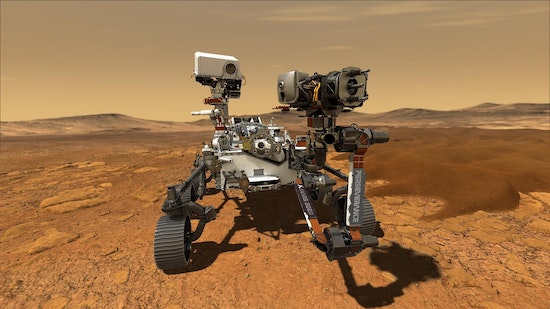On February 22, 2021, NASA’s Perseverance Rover made history when it recorded its vertiginous drop towards Mars, its Entry, Descent, and Landing (EDL) camera capturing the dunes’ jagged folds and blood-shadows as the probe hurtled towards Jezero Crater at 12,500 miles per hour. In the days following the Rover’s landing, NASA engineers exalted the mission’s success; they shared videos of the debris plumes that coursed from the Rover’s engines and the winds that convulsed its DPA microphones when it finally touched down, affirming that Mars’ “true” soundscape had now been documented in audible high fidelity for the very first time.
Following two failed attempts to record audio on a Red Planet mission – the Polar and Phoenix Landers launched in 1999 and 2008, respectively – Perseverance is the first time a space probe has registered an extraterrestrial landscape’s natural sonic environment.
“It gives me goosebumps every time I listen to it,” said David Gruel, an engineer at NASA’s Jet Propulsion Laboratory, in a press conference following the event. As the Rover explores the planet in search of chemical signs of ancient microbial life, he added, the audio will help bring the Martian landscape closer for all of us.
But the 20-second-long clips of Mars’ winds, which can be heard on NASA’s Soundcloud below, are agonizingly faint, requiring over-ear headphones or a full stereo system to make out its subdued symphony of low-frequency hisses, pops, and whistles against the Rover engine’s guttural roar. The page’s comment section is a chronicle of disappointments: “No sound at all … ,” “Not what I expected,” and “Did the tree fall?” are among some of the listeners’ criticisms. A deep roll of bass at the threshold of audibility, the Martian winds are almost a suggestion of a sound rather than a veracious recording of one – a feeble tap on the window when we were expecting a battering ram against a dungeon door.
The challenges in discerning the wind sounds are two-fold. In the absence of a protective shield, the frequencies picked up by the microphone are predominantly the result of pressure fluctuations in the air rather than qualities inherent to the Martian winds themselves. “Wind requires an opposing force to be heard,” sound designer and musician Ben Frost told me over email. “Most field recording setups involve huge furry windjammers to try and stop the wind from reaching the delicate diaphragm of the microphone, which is why we don’t hear the wind, but its buffeting, on the Perseverance’s [DPA].”
Mars’ atmosphere is also one-per-cent as dense as Earth’s, containing only a small amount of water vapor through which sound waves can travel. As a result, high frequencies attenuate quickly, losing amplitude as they’re absorbed into the carbon dioxide-rich environment. <a href=”https://news.psu.edu/story/202637/2006/06/28/can-you-hear-me-now-not-mars
“ target=”out”>According to the simulations of Penn State acoustics researchers Amanda Hanford and Lyle Long, a scream that travels a kilometer on Earth would journey only some around 14 metres on Mars. The planet, like the few other outer space events audible within our limited hearing range, is mostly silent.
The grousing public response to Perseverance’s muffled recordings is largely a result of our rich cultural imagination of sound in outer space. Sonic interpretations of the universe began at least as early as the 1930s, when engineers Nikolai Tesla, Guglielmo Marconi, and Karl Jansky began monitoring radio signals to substantiate their claims that they were receiving interplanetary messages from technologically advanced civilizations. In the 1950s, the confluence of the rapid development of rocket science with the battle for both militarized and soft power between the United States and the USSR cemented our collective fascination with science fiction and space cinema. As more films began depicting frontiersman-like explorations of our universe, futuristic electronic tonalities evoking the dreamlike and Pascalian wonder of infinite space quickly followed.
In reality, audible sound waves don’t propagate in our universe’s near-vacuum, but there are still frequencies that fall beyond the 20 Hz to 20 kHz human hearing range – especially in the infrasonic and ultrasonic spectra – that abound in the cosmos. A few people have even attempted to simulate these bizarre sonic phenomena, including Dr Timothy Leighton, a theoretical physicist and expert in extraterrestrial acoustics at the University of Southampton. In sharing NASA’s delight that a microphone finally landed on Mars, Dr Leighton explained over Zoom that there is a universe of other, even more acoustically-exciting, places to explore.
“Venus is really the most musically interesting planet because the fluid loading effect is so great,” he told me. “When you have an aqueous mixture in an atmosphere, you have the possibility of other sounds to do with bubbles, breaking waves, babbling brooks, and waterfalls.” Putting sound sensors within the ice fields on Jupiter and Saturn would yield “an incredibly rich environment” full of ice cracks and geothermal activity, he added. Other fascinating sound sources from our galaxy’s planets and moons would emanate from methane lakes on Titan, terrestrial thunder and atmospheric lightning on Venus, and cryo-volcanoes spewing streams of hydrocarbons, minerals, and ammonia on Io and Europa.”
In July 2009, Dr Leighton published a paper entitled The Sound of Music and Voices in Space in which he applied predictive models to infer how some of these alien environments might resonate in human ears. “Bach’s Toccata and Fugue in D minor (293.66 Hz) played on the flue (not reed) pipes of a church organ on Titan will automatically be transposed down to the key of ~F# minor (185 Hz),” he writes, “while Venus’ dense and hot (457 ˚C) atmosphere transposes it up to ~F minor (349.23 Hz).
“If a small child were to speak on the latter’s carbon dioxide-abundant landscape," he continues, "they would sound like a Smurf – a small body with a baritone voice – because their vocal folds would move slowly in response to the planet’s thick atmosphere, but the sound speed in their windpipe would be very high (making them sound smaller).”
The article is accompanied by a dense wall of equations that consider each planet’s gaseous properties, atmospheric sound speed, and non-acoustic signals in a mind-bending calculus. It’s also joined by infinitely more accessible sound bites that estimate acoustic phenomena from other worlds. The control file – gas bubbling through water on Earth – emits a burble not unlike the gentle ebb of a stream. But the same sound on Titan is a mangled form of Earth’s aqueous pitter-patter, its rounded contours sharpened into a serrated metallic edge.
While Dr Leighton’s work is conjectural at this stage, there’s a trove of other real space sounds that have been captured and converted into audible frequencies. NASA’s comically-titled compilation Spooky Space Sounds from Across the Solar System makes some of these available in a 30-track Soundcloud post. It includes Saturn’s radio emissions as recorded by the Cassini spacecraft, a flyby of comet Tempel 1 as “heard” by an instrument on the protective shield of NASA’s Stardust, the sonification of a Hubbel deep space image, and the watery hiss of plasma waves. “Like the roaring ocean surf, plasma creates a rhythmic cacophony that we can hear across space,” reads the explanatory text on NASA’s website – though to be made audible, they must first be mixed with higher frequencies situated within our hearing range.
The fact that these sounds aren’t immediately discernible to the human ear makes them even more interesting to Chris Watson, one of the world’s foremost wildlife sound recordists (and a founding member of the legendary industrial-pop act Cabaret Voltaire). Watson works closely with underwater environments and sees noteworthy parallels between the sounds of the seas and those of the planets.
“Sound is a vibration,” he explained over the phone. “If you’re in the water with a singing humpback whale, you feel the song – you can’t necessarily hear it.” And while a device called a hydrophone can convert these low frequencies into higher ones that the inner ear can transduce, to Watson, the excitement of listening to a whale is in what he experiences in the water, not in what he can instantly pick up and analyse. “There’s literally a whole universe of sound outside of our human frequency range,” he said. “And that’s what excites me about the sounds of the planets. Not the wind noise from Mars, but the physicality of what we can’t hear.”
Watson attributes the hype around the recently-recorded winds to the absence of a precedent or collective memory of the Martian soundscape (“I think the prospect of it was probably more engaging and exciting than the reality,” he admitted). But what the sounds do succeed in doing, he emphasized, is activating our imaginations. Sound is an evocative stimulus that, like smell and taste, can trigger rich memories in highly precise ways. “Even if we listen to a sound in darkness, or even without an external reference, we can build a very powerful image of what that place is like,” Watson said. “We can make it our own.”
Thought of in this sense, the wind-battering picked up from the Perseverance Rover is significant, perhaps not in its ability to accurately render Mars with any dynamic and nuanced verisimilitude, but rather to implicate our human presence within that landscape. The sound of the DPA microphone under duress from the Martian dust currents gives us the immense and paradoxical gift of cosmic perspective. Here, even with a limited set of sensory inputs, one could envision gazing out over the crater-pocked horizon and feeling like a pioneer, or an exile, while reedy skirls of wind whistle past. There’s an eerie quality in this emptiness that no words or visual image could convey, but that these audible vibrations readily stir to imagination as we confront the awe of infinitude.
Chris Watson and Ben Frost both feature on the Unsound Intermission compilation album, which you can found out more about here





